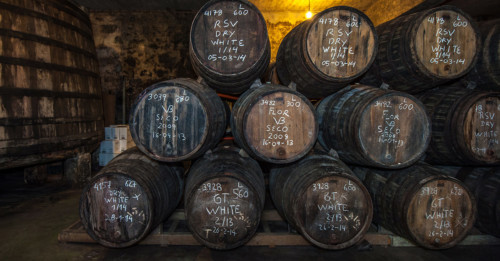Sherry Essential Info
- Color: Very light gold to amber to rich, nutty brown
- Region: Spanish province of Cadiz
- ABV: Varies, 15%-22%
- Aged: Varies, aged in wood casks in the Solera system; can be aged for decades but often sold younger
- Made from: Palomino Basto, Palomino Fino, Pedro Ximenez, and Muscat grapes
- Commercial Examples: Emilio Lustau, Williams & Humbert, Domecq, Gonzalez, Hidalgo, Tio Pepe
- Popular Cocktails: Sherry Flip, Sherry Cobbler, The Up-to-Date
Sherry: the stuff of grandmotherly sipping? Not anymore. Not that grandmothers (and fathers) shouldn’t sit down with a nice cream sherry to soak away the day, but the world of sherry appreciation is rapidly expanding far beyond any tidy stereotypes (in large part thanks to the interest of a new class of “mixologists”).
For a newbie, sherry might seem too complicated or prim, but it’s actually one of the most approachable and interesting products in the world of alcohol. Like Port, it’s a fortified wine, meaning Sherry starts life as wine until someone dramatically interrupts it with a heaping serving of high-ABV neutral grain spirit (usually grape based). Not only does the spirit lift Sherry’s ABV, it kills off any remaining yeast, stopping fermentation. But for Sherry, that’s just the beginning.
What really defines Sherry (beyond the grapes and terroir, ahem) is the way it’s aged: the different types are basically expressions of the science, and slightly frustrating magic, of aging. All Sherry is aged with the Solera system—basically a cask-rotation system where the final product is a blend of younger and older Sherries. But while some sherries are oxidized—meaning allowed exposure to oxygen, which impacts the flavor—some are intentionally deprived, kept under a naturally occurring (and systematically encouraged) layer of yeast called a “flor,” basically a club bouncer for oxygen trying to get into the party. Because the flor comes from ambient yeast in the winery, where Sherry is aged becomes part of its expression. When the flor disappears, on purpose or by accident (see below), oxidation occurs and darker, richer flavors arise—which is one reason why sherry can achieve the incredible hoodwink of having a sweet, fruity, nutty aroma and a bone-dry mouthfeel. (Also makes it great for food pairings and, yes, cocktails.)
Here are the basic Sherries, and why each is worth exploring:
Manzanilla and Fino both age under a layer of protective yeast “flor,” lending them a bone-dry, nutty, tart and pleasantly yeast character, but because Manzanilla comes from a seaside town, it has a slightly brighter salinity (as you might expect from an Islay Scotch).
When flor can’t survive, you get Amontillado or Oloroso. Amontillado is a sherry that’s been allowed some oxidation, lending it more depth and nuttiness, while Oloroso is fortified to a level where flor can’t really survive, so it oxidizes more, with darker fruit and nut notes and even an impression of sweetness.
Palo Cortado is a super rare Sherry that kind of exemplifies the mystery of it all: it starts life as a Fino or Amontillado (under the flor yeast), only to randomly—as in not by design—lose its flor, and continue aging as an Oloroso (with exposure to oxidation). The resulting Sherry combines the crisp, dry, delicate flavors of a Fino or Amontillado with the richness of Oloroso. (Because of its popularity, some winemakers may “fake” a Palo Cortado by combining Amontillado and Oloroso—cheaper, and not necessarily bad, but not quite the same.)
Pedro Ximenez is a dessert Sherry. Made with at least 85% Pedro Ximenez grapes (picked super-mature and/or sun-dried), it’s a silky-sweet, rich, aromatic wine that gains more nuttiness, herbaceousness, and funk as it ages.
Despite the name, Cream Sherry has absolutely no dairy in it. A dark, sweet dessert Sherry, usually an Oloroso with sweeter Sherry (Pedro Ximenez) or Moscatel wine blended in. Good for dessert, no shawl or tea set required.
